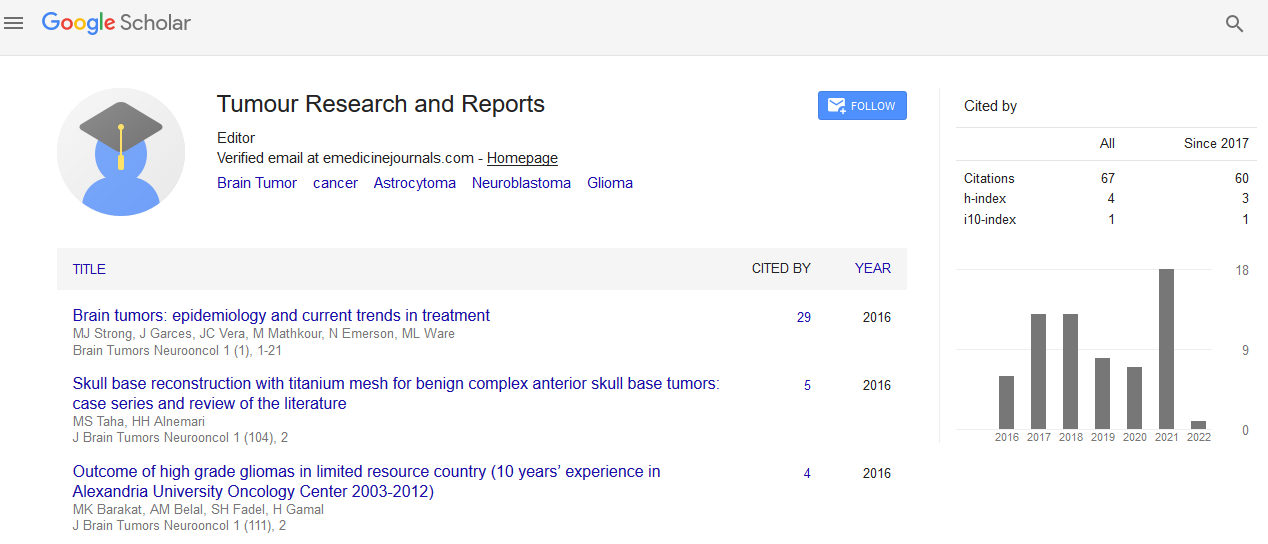Indexed In
- RefSeek
- Hamdard University
- EBSCO A-Z
- Google Scholar
Useful Links
Share This Page
Journal Flyer

Open Access Journals
- Agri and Aquaculture
- Biochemistry
- Bioinformatics & Systems Biology
- Business & Management
- Chemistry
- Clinical Sciences
- Engineering
- Food & Nutrition
- General Science
- Genetics & Molecular Biology
- Immunology & Microbiology
- Medical Sciences
- Neuroscience & Psychology
- Nursing & Health Care
- Pharmaceutical Sciences
Perspective - (2024) Volume 9, Issue 4
Assessing the Emerging Link between Low-Level Arsenic Exposure and Kidney Cancer Risk
Taehyun Sansom*Received: 29-Nov-2024, Manuscript No. JTRR-24-27826; Editor assigned: 02-Dec-2024, Pre QC No. JTRR-24-27826 (PQ); Reviewed: 16-Dec-2024, QC No. JTRR-24-27826; Revised: 23-Dec-2024, Manuscript No. JTRR-24-27826 (R); Published: 30-Dec-2024, DOI: 10.35248/2684-1614.24.9.241
Description
Arsenic is a naturally occurring element that is widely distributed in the Earth's crust, and it can enter drinking water supplies through natural processes such as the dissolution of minerals or through human activities such as mining and industrial discharge. While arsenic exposure is known to pose a significant risk for various cancers, including lung, skin, and bladder cancers, recent studies have raised concerns about the potential link between low-level arsenic exposure in drinking water and kidney cancer risk. This article aims to explore the emerging evidence connecting arsenic exposure to kidney cancer, discuss possible mechanisms, and highlight the need for further research and public health action [1,2].
Historically, arsenic exposure from drinking water has been associated with significant health risks, especially in regions where high levels of arsenic are found naturally, such as parts of South Asia, Latin America, and even in certain areas of the United States. The World Health Organization (WHO) and the U.S. Environmental Protection Agency (EPA) have set strict limits on arsenic concentrations in drinking water—10 micrograms per liter (μg/L)-as a safety threshold, based on the carcinogenic potential of the element at higher concentrations [3].
However, emerging research suggests that even low levels of arsenic exposure, below the regulatory limit, may still have adverse effects on human health, particularly when it comes to kidney cancer. Studies have indicated that long-term, low-level exposure to arsenic can lead to a range of chronic health conditions, including cardiovascular disease, diabetes, and various cancers, with kidney cancer being one of the most concerning [4,5].
Several epidemiological studies have reported a correlation between low-level arsenic exposure in drinking water and an increased risk of kidney cancer, though the evidence remains somewhat inconclusive. A study published in 2014 found that people exposed to arsenic concentrations below 10 μg/L had a higher risk of developing kidney cancer compared to those with no exposure. Another large-scale study conducted in Taiwan, where arsenic concentrations in drinking water are elevated, indicated that even low levels of arsenic exposure could contribute to kidney cancer risk, particularly for individuals who have been exposed over long periods.
While these findings suggest a potential link, it is important to note that the relationship between arsenic exposure and kidney cancer is complex, and not all studies have reached the same conclusion. The challenge lies in the fact that kidney cancer has multiple risk factors, including smoking, obesity, and genetic predisposition, which complicates the isolation of arsenic as the sole contributing factor. Moreover, arsenic's effects on the kidneys may be influenced by other environmental exposures and health conditions, making it difficult to establish a direct causeand- effect relationship [6,7].
Arsenic is a potent toxicant that can cause damage to cellular structures and disrupt vital biological processes. One of the key mechanisms by which arsenic may contribute to kidney cancer is through its ability to interfere with DNA repair mechanisms. Arsenic exposure has been shown to induce oxidative stress, which in turn can lead to DNA mutations and promote tumorigenesis. Additionally, arsenic is known to alter gene expression and epigenetic pathways, further increasing the likelihood of cancer development in susceptible individuals [8].
Arsenic also has a direct toxic effect on kidney cells. The kidneys, responsible for filtering toxins from the blood, may accumulate arsenic over time, leading to cellular damage and inflammation. Inflammation is a well-known risk factor for cancer, as it can promote the growth of abnormal cells and the development of tumors. Arsenic’s ability to disrupt normal cellular processes makes it particularly concerning as a potential carcinogen in the kidneys [9,10].
Conclusion
The link between low-level arsenic exposure in drinking water and kidney cancer risk is an emerging area of public health research that warrants further attention. Although existing studies suggest a potential association, there is still much to be understood about the underlying mechanisms and the level of exposure that poses the greatest risk. As arsenic contamination remains a significant problem in many parts of the world, ongoing efforts to improve water quality and reduce exposure, alongside further research into the effects of low-level arsenic exposure, are crucial for safeguarding public health and reducing the burden of kidney cancer.
References
- Vasudevan D, Gajendhran B, Swaminathan K, Velmurugan G. Host-microbiota interplay in arsenic metabolism: Implications on host glucose homeostasis. Chem Biol Interact. 2024;111354.
[Google Scholar] [Crossref] [PubMed]
- Padilla-Reyes DA, Duenas-Moreno J, Mahlknecht J, Mora A, Kumar M, Ornelas-Soto N, et al. Arsenic and fluoride in groundwater triggering a high risk: Probabilistic results using Monte Carlo simulation and species sensitivity distribution. Chemosphere. 2024;359:142305.
[Google Scholar] [Crossref] [PubMed]
- Chin WS, Hung WL, Say YH, Chien LC, Chen YC, Lo YP, Liao KW. The influence of exposure to inorganic arsenic and other arsenic species on early renal impairment among young adults in Taiwan. Environ Pollut. 2024;363:125090.
[Google Scholar] [Crossref] [PubMed]
- Chen X, Liu S, Luo Y. Spatiotemporal distribution and probabilistic health risk assessment of arsenic in drinking water and wheat in Northwest China. Ecotoxicol Environ Saf. 2023;256:114880.
[Google Scholar] [Crossref] [PubMed]
- Mukherjee M, Brandenburg L, Dong Y, Pfister S, Sidler A, Ramette A, et al. Microbiota-dependent in vivo biotransformation, accumulation, and excretion of arsenic from arsenobetaine-rich diet. J Haza Mater. 2024;480:136463.
[Google Scholar] [Crossref] [Pub Med]
- He T, Xiong L, Lin K, Yi J, Duan C, Zhang J. Functional metabolomics reveals arsenic-induced inhibition of linoleic acid metabolism in mice kidney in drinking water. Environ Pollut. 2024;349:123949.
[Google Scholar] [Crossref] [PubMed]
- Traven L, Marinac-Pupavac S, Zurga P, Linsak Z, Zezelj SP, Glad M, et al. Arsenic (As), copper (Cu), zinc (Zn) and selenium (Se) in northwest Croatian seafood: A health risks assessment. Toxicol Rep. 2023;11:413-419.
[Google Scholar] [Crossref] [PubMed]
- De Loma J, Krais AM, Lindh CH, Mamani J, Tirado N, Gardon J, et al. Broberg K. Arsenic exposure and biomarkers for oxidative stress and telomere length in indigenous populations in Bolivia. Ecotoxicol Environ Saf. 2022;231:113194. [Google Scholar]
- Ur Rahman S, Liu X, Khalid M, Rehman A, Cao J, Kayani SI, et al. Beyond contamination: Enhancing plant tolerance to arsenic through phytobial remediation . S Afr J Bot. 2024;164:250-265.
- Han Y, Gao T, Li X, Wāng Y. Didactical approaches and insights into environmental processes and cardiovascular hazards of arsenic contaminants. Chemosphere. 2024;352:141381.
[Google Scholar] [Crossref] [PubMed]
Citation: Sansom T (2024). Assessing the Emerging Link between Low-Level Arsenic Exposure and Kidney Cancer Risk. J Tum Res Reports. 9:241.
Copyright: © 2024 Sansom T. This is an open access article distributed under the terms of the Creative Commons Attribution License, which permits unrestricted use, distribution, and reproduction in any medium, provided the original author and source are credited.

